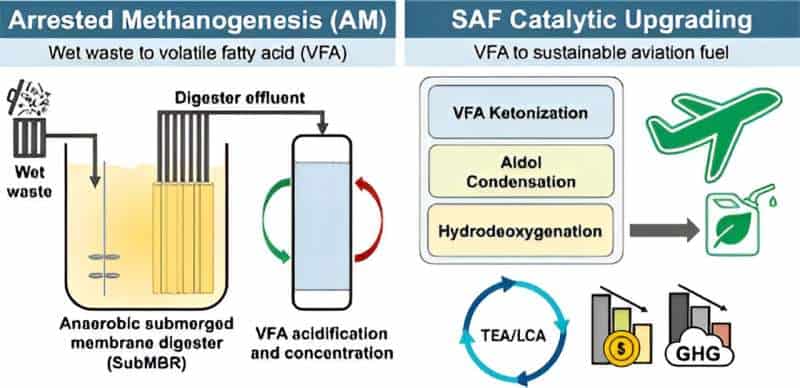
Made from renewable materials like biomass and agricultural waste, sustainable aviation fuel has enormous potential to decarbonize the aviation industry. But widespread adoption has yet to take off.
Sustainable aviation fuel (SAF) makes up less than 1% of the fuel used in the aviation industry, while aviation fuel contributes about 3% of global greenhouse gas (GHG) emissions. Producing SAF that is more energy efficient, cheaper and cost-competitive with fossil-based jet fuel is critical to widespread commercial use.
Now scientists at the Argonne National Laboratory have developed a novel technology that creates a cost-competitive SAF that could reduce GHG emissions in the aviation industry by up to 70%. Argonne’s life cycle and techno-economic models were used to analyze the environmental impacts and economic viability of the SAF.
The research in ACS Sustainable Chemistry & Engineering shows that novel methane arrested anaerobic digestion (MAAD) technology converts high-strength organic wastewater into volatile fatty acids, which can be upgraded to SAF.
As key precursors for SAF production, volatile fatty acids can play a critical role in decarbonizing the aviation industry, said Haoran Wu, an Argonne postdoctoral researcher.
“Volatile fatty acids from waste streams can make biofuel production more cost-effective and sustainable,” said Wu. “Argonne’s novel technology uses a membrane-assisted bioreactor to enhance the production of volatile fatty acids.”
The research advances goals outlined in the DOE’s Sustainable Aviation Fuel Grand Challenge which aims to increase the production of SAF to three billion gallons by 2030. The goal is to produce enough fuel to meet 100% of commercial jet fuel demand by 2050.
Converting waste streams to biofuel
Biofuel is in demand to decarbonize hard-to-electrify sectors like aviation. Converting biomass to biofuel is a complex process involving variables in organic materials used as feedstock, as well as conversion, separation and purification technologies to meet fuel specifications.
Instead of relying on more conventional resources like fat, oil and grease, scientists used carbon-rich wastewater from breweries and dairy farms as a feedstock for their innovative technology. In a key advancement, the technology strips organic carbon from these high-strength waste streams that are otherwise difficult to treat cost-effectively.
“Both wastewater streams are rich in organics, and it is carbon-intensive to treat them using traditional wastewater treatment methods,” said study author Taemin Kim, an Argonne energy systems analyst. “By using our technology, we are not only treating these waste streams but making low-carbon sustainable fuel for the aviation industry.”
Argonne’s technology also breaks new ground in converting these waste streams to SAF.
Anaerobic digestion is an established technology for converting biomass to methane and then to biofuel. Developed by Meltem Urgun Demirtas, department manager of Sustainable Materials and Processes at Argonne, the MAAD technology instead focuses on the production of volatile fatty acids (such as butyric acid) and lactic acid.
However, lactic acids limit the production of SAF from volatile fatty acids. The Argonne MAAD technology overcomes that limitation to increase volatile fatty acid yield.
“Lactic acid lowers the carbon efficiency when converting volatile fatty acids to SAF,” Wu said. “Therefore, shifting conversion away from lactic acid toward volatile fatty acid production is key.”
In another novel innovation, scientists developed an electrochemical separation method to enhance the membrane-assisted MAAD technology.
“We developed an in-situ product recovery process to increase retention time in the membrane-assisted digesters, which allowed resilient microbial communities with abundant butyric acid producers and increasing acid productivity and concentration, hence decreasing acid production cost and acid toxicity,” said Urgun Demirtas, a principal investigator on the research.
Analyzing economic and environmental impacts
With the experimental data, scientists used Argonne’s advanced simulation and modeling tools to design three possible waste-to-SAF pathways and compared them to conventional jet fuel produced from fossil fuel.
Using the process models, scientists conducted a techno-economic and life cycle analysis of the pathways. The life cycle analysis was conducted using Argonne’s R&D Greenhouse gases, Regulated Emissions, and Energy use in Technologies (R&D GREET) model to evaluate GHG impacts from production to end use.
Scientists say the waste-to-aviation fuel pathway significantly cut carbon emissions compared to conventional jet fuel. The study also expands the use of lesser-used waste materials at a time when demand for typical bio-feedstock for SAF results in a shortage.
While research will continue, ultimately, scientists hope to commercialize the patent-pending process and scale the technology for widespread use.
“Designing a membrane-assisted technology that achieves a 70% reduction in greenhouse gases at a cost comparable with conventional jet fuel is a significant advancement,” Wu said.
“We will continue working to enhance sustainability and begin exploring other feedstock materials to use with our technology.”
Pahola Thathiana Benavides Gallego, an Argonne principal energy systems analyst, also served as a principal investigator on the research.